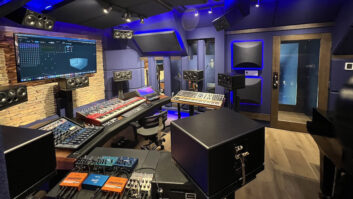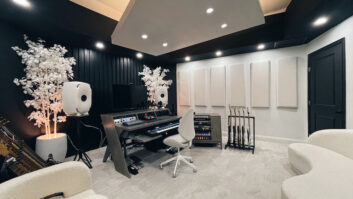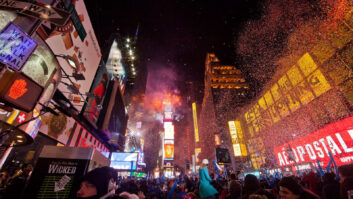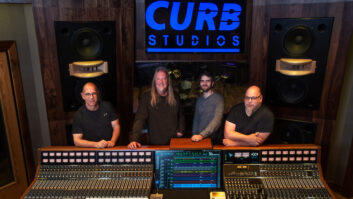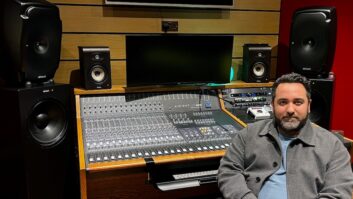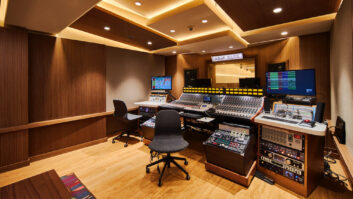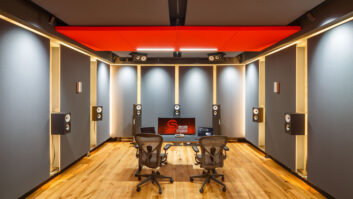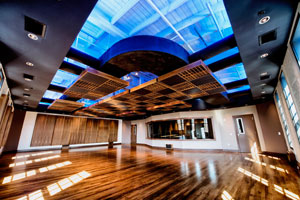
Photo: Lucia De Giovanni for Think Loud Studios
On the Cover: Think Loud Studios, York, Pa.
“As a lifelong musician, producer and engineer, I have to say, Think Loud Studios is the ultimate reward for all those years of hard work and dedication,” says Chad Taylor, best known as the lead guitarist for the band LIVE. Taylor and bandmates Patrick Dahlheimer (bass), Chad Gracey (drums) and Chris Shinn (vocals) co-own this creative, multi-use showplace, which was built into a 100-plus-year-old landmark building full of vintage touches and natural light.
The landmark status of the structure, a former printing house, created some obstacles for Horacio Malvicino, whose Malvicino Design Group provided the acoustical and spatial design for the facility. “We had to keep the structure and existing windows as they were,” Malvicino explains. “But there are train tracks 100 feet away, and an SPL reading in the room showed the locomotive horns at 95 dB.”
Anderson Windows created custom double-paned windows for the exterior of the existing ones, and Soundproof Doors manufactured 5-inch-thick windows for the interior side. “The city approved the design, but they wanted us to be able to open them, so Randy Brown from Soundproof Doors engineered a special hinge system so they would open but not cave with the weight.”
Malvicino balanced all that reflective glass with movable panels and clouds that offer variable acoustics in the main tracking room and Studio B, which doubles as a rehearsal space. The treatments were manufactured by Veronica Bernal for TADI.

Think Loud Studios Control Room
Photo: Lucia De Giovanni for Think Loud Studios
City requirements may have proved challenging for the acoustician, but Taylor says local government is a big reason his “ultimate reward” got built. “Our governor, Tom Corbett, and his wife, Susan, stand up for the arts in a way that I’ve hardly seen,” Taylor says. “The arts initiative our state government has set up [with tax incentives and benefits] for artists allowed LIVE to come back to our hometown of York.”
All of the audio equipment in LIVE’s new studio was provided by GC Pro, whose account manager Billy Walker provided on-site support during the installation, while system integration was done by MDG’s Inaki Prades Cardenas. Control room A offers an SSL Duality, Pro Tools HDX 3 and Ocean Way main monitors; the B room includes an Avid Control Surface, Pro Tools HDX 2 and Ocean Way AS-1 mains.
The building also houses a studio kitchen, lounge, offices, residential accommodations, gym and spa, a private theater and a rooftop deck.
“We told Horacio that the view from Studio A, overlooking the rooftops and church steeples of York, inspires us as artists,” Taylor says. “The vaulted ceilings in these rooms inspire us. We gave him some challenges on the architectural side and the audio side, but he was able to give us everything we asked for, and we were able to get brilliant sounds right off the bat.”

Photo: Skip Burrows

Baum Haus Studios Control Room
Photo: Skip Burrows
Baum Haus Studios, Houston, Texas
Acoustical and architectural design for this ground-up facility were created by Martin Pilchner of Pilchner Schoustal International, with engineering/technical infrastructure by Skip Burrows of Sunrise Recording Services. Included are a large control room and live room, three isolation booths with varying acoustics, machine room and numerous client amenities. Among the inventive acoustical treatments is the elaborate organic tree branch diffusor that Pilchner designed for the rear wall of the control room. The tracking room offers flexible acoustic elements that vary decay times by more than a second. Featured equipment at Baum Haus includes a 48-channel Wunder console and a CLASP system.

Photo: Juergen Nogai Photography
Windmark Studios, Santa Monica, Calif.
After acquiring Windmark Studios, musician/composer Michael Marquart brought in Peter Grueneisen of studio bau:ton and nonzeroarchitecture to design a new recording suite comprising a control room, large tracking room and vocal booth. Wood and fabric finishes, and color-changing LED lighting were used in this vintage-inspired space, which includes one of four existing Neve A4310-12 CBS Sony custom consoles in the world, an Ampex 16-track 2-inch machine formerly owned by Les Paul, and a prized collection of outboard gear and mics.

Photo: Massimo Scarparo
Forward Studios, Grottaferrata, Italy
Francis Manzella redesigned the control room of the flagship Caesar Studio in this three-studio complex just outside of Rome. Acoustical renovations included adding extensive tuned low-frequency trapping, and new reflection-control and rear-wall diffusive treatments. The rooms are refinished with a new fabric skin, woodwork and a new RGB LED lighting system. Equipment includes a 72-input Neve 88R console, Studer A820 machine, Genelec 1035B mains, and a range of analog and digital processing.

Photo: Andrea Hallgren
Columbia Studio A, Nashville, Tenn.
Belmont University’s Mike Curb College of Entertainment and Music Business renovated this historic Music Row studio with an acoustical design by Dave Rochester of Technical Audio Services. The facility is used for classes, seminars and recording sessions. Refurbishments include the addition of custom maple paneling and absorptive treatments, including TAS-designed bass trapping in the studio and control room. The control room features a 1972 API split-monitor console formerly owned by Wally Heider, JBL M2 monitoring system, a Studer A827 tape machine and Pro Tools 10.

Photo: Tim Gaudreau
Electric Tree House, Bedford, Mass.
Lou Clark of Sonic Space designed this new studio for engineer Alec Francesconi. In the control room are deep side-wall bass traps on each side of the Dynaudio monitors, three feet of trapping in the ceiling with custom-built wood grid floating in the center of wall-mounted soffitts, and a rear-wall bass trap with flush-mounted Acoustic Ramp diffusors by XIX Acoustics. The console area has a raised floor between the speakers and listener to remove floor-reflected energy, while the live room features a variable-acoustic gobo system and a large cylindrical ceiling diffusor. Francesconi works mainly in Pro Tools, using a range of outboard pre’s, processing and plug-ins. Interior design was by Michelle Puntillo.

Photo: Ricky Hosn
Quad Recording Studios, New York City
Quad’s Q1 control room was redesigned by the Walters-Storyk Design Group for studio owners Ricky Hosn and Alessio Casalini. The studio was originally built in 2010 around a large rack that doubled as a production desk. The goal of the redesign was to create more leg room in the 320-square-foot space, and generally upgrade the sonics and aesthetics. Existing Augspurger mains were upgraded with custom digital amps and an integrated DSP processor, the tweeters were replaced with new Beryllium diaphragms, and two 18-inch subwoofers were added. The studio also includes a 32-channel Avid Icon console, Pro Tools HD4, an SSL X Logic 16-channel summing mixer, and a Chandler 16×2 Minirack mixer.

Photo: Lou Johnson
Fly by West, Nashville, Tenn.
The second studio that Carl Tatz designed for engineer/producer Derek West, Fly by West, is built into a former boathouse. The CTD MixRoom includes Tatz’s Signature Series acoustic modules by Auralex, and Dynaudio BM6A Professional monitoring augmented by the designer’s proprietary PhantomFocus System. The adjacent tracking room has 20-foot ceilings and includes a multi-use loft.

Photo: Scott Chebegia
Hybrid Studios, Santa Ana, Calif.
Delta H Design’s project Hybrid Studios employs a variety of designer Hanson Hsu’s unique approaches to acoustic design. The ZR Acoustics Prefab control room and surface-treated live room are designed to require no bass traps or room EQ. The ZR Micro and Sample Rate 8-bit acoustical art panels, designed to create lifelike aural imaging, line the walls of the live room pictured here. Hybrid features an SSL 4064 G-Plus console, Pro Tools 10/11 and Genelec 1032A, ADAM S3A, and Yamaha NS-10 monitoring.

Orb Tracking Room
Photo: Harrison Funk

Orb Control Room
Photo: Harrison Funk
Orb Recording Studios, Austin, Texas
Designed by Mark Genfan, Orb is a brand-new 5,600-square-foot ground-up facility in the Texas hill country. The large, versatile recording and mixing rooms include natural wood and stone finishes, as well as custom RPG Wave Gaussian and Acoustic Geometry Curve diffusors that add control and color to the room tone. The new studio is equipped with an SSL G Plus console, Ampex ATR-102 tape machine, Ocean Way HR2 mains, Chris Pelonis Signature PSS110 monitors, and a 1938 Steinway grand piano.

Photo: Leanne Haddad/Clicks for a Cause
Fox River Studios, De Pere, Wisc.
This private residential studio is built into a detached boathouse/garage that was split in two: One half for music; the other a photography studio. Gavin Haverstick from Haverstick Designs developed the recording side, which includes a 215-square-foot control room, 268-square-foot live room, and a 37-square-foot vocal booth. A room-within-a-room design and doors from IsoStore were used to isolate the studio from a nearby busy waterway. Also featured are custom bass trapping and absorptive treatments, and diffusors from RPG and Kinetics Noise Control. Fox River is equipped with Pro Tools and Digital Performer, and Focal SM9 and Avantone monitors.

Photo: Espen Lind
Norsk Innspillingsbyra AS, Oslo, Norway
Jeff Hedback of HD Acoustics designed this production and mixing studio for songwriter/producer Espen Lind. The facility comprises a 900-square-foot multifunction space plus an iso booth with 16-foot ceilings and an upper coupled space/chamber. Hedback’s design implements acoustical products from ASC Attack Wall, GIK Acoustics, RealTraps, Auralex and Resonator Stockholm Optiffusers. Espen’s equipment includes an Avid D-Command, Pro Tools HDX, Guzauski-Swist GS3A monitors and an EMT 140 stereo plate reverb.

Photo: Jay Kaufman
Ninja Tracks, Encino, Calif.
Kaveh Cohen and Michael Nielsen’s new production facility was designed by Jay Kaufman with efficiency and creative freedom in mind. It houses two production studios, an iso room and machine room, as well as office and kitchen facilities, and a living room that doubles as a reverberant live room when needed. Kaufman designed custom acoustical treatments for each space. Key equipment includes Mac Pro workstations running Logic Pro and 128 channels of Apogee Symphony, Barefoot MicroMain 27 monitors, and processing from API, Manley, Neve, Overstayer and more.

Photo: Wes Lachot
Bunkersound, Chapel Hill, N.C.
This facility’s reflection-free-zone control room employs RPG diffusors and diffsorptive side wall treatments designed to help extend the sweet spot into the rear of the room. Tracking room treatments also include a complement of RPG diffusion, absorption and bass trapping. Bunkersound was designed by the Wes Lachot Design Group. Equipment includes a Neve Genesys console, Pro Tools HDX system with Apogee Symphony converters, and ATC SCM 110ASL main monitors.

Photo: Andy Hutchinson
Zelig Studio, London
Award-winning designer Steve Durr collaborated with UK-based designer Chris Walls and DDC construction to create this warm, flexible personal studio for producer/composer Mark Ronson (Amy Winehouse, Rufus Wainwright, Kaiser Chiefs, etc.). This unique room design incorporates both the vibe for capturing live music and the flexibility for creating a performance. The studio is situated in London’s Tileyard studio complex and features a 32-input MCI 528 console refurbished by Malcolm Atkin, Studer A800 tape machine, Scully 8-track recorder, and a wide selection of vintage outboard gear.

Photo: Marc Senasac
Sony PlayStation Recording Studios, San Mateo, Calif.
The game giant’s new audio facility, designed by Chris Pelonis, opened last August and appeared on Mix’s cover the following month. Nineteen studios were constructed in a 25,000-square-foot complex that accommodates an extensive range of audio disciplines. Pelonis’ unique approach to design provides variable acoustics to support an unlimited array of recording palettes. All rooms are designed and optimized for stereo to 7.1 playback. A 1,500-square-foot live recording suite is equipped with an API 1608 and Avid D-Command hybrid console, and a 7.1 post/game-mix stage featuring an Avid System 5 Fusion. All rooms feature Pelonis Signature Series speaker systems.

Photo: Russ Berger Design Group
HEARby Sound, Seattle, Wash.
Studio owners John and Nannette Buroker worked with the Russ Berger Design Group to transform a storefront into this busy facility, where they provide sound design, audio post and custom music services. RBDG’s acoustical design isolates the control room, studio and support spaces from nearby streets. The studio was designed to provide client comfort and freedom from the typical studio “box,” with a sophisticated vibe. Featured equipment includes top-quality vocal microphones, preamps from API, Wunder, Helios, and Chandler Limited, and a Genelec 8050 5.1 system.
